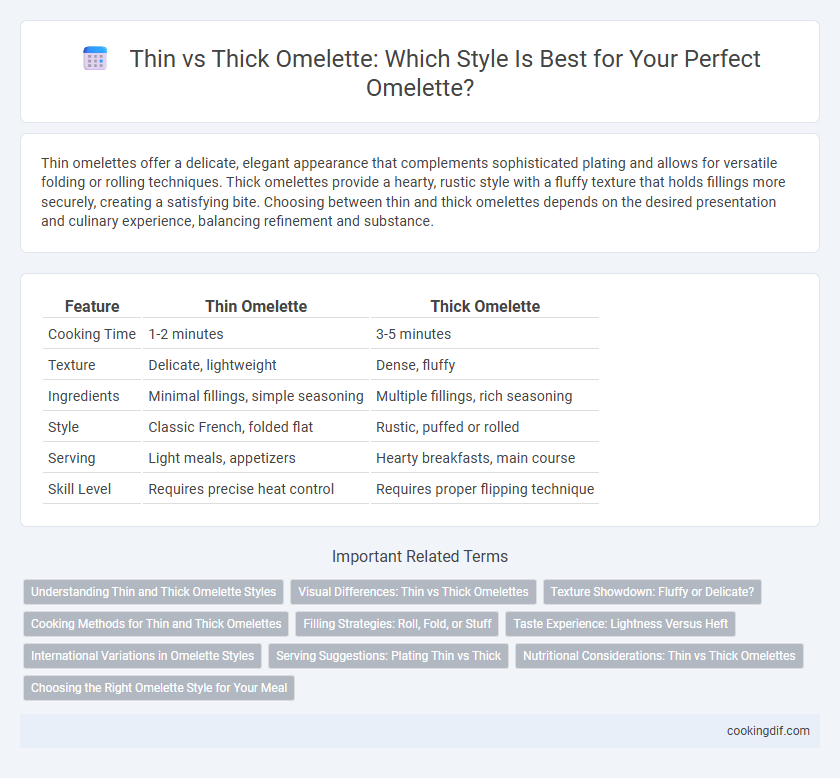Thin omelettes offer a delicate, elegant appearance that complements sophisticated plating and allows for versatile folding or rolling techniques. Thick omelettes provide a hearty, rustic style with a fluffy texture that holds fillings more securely, creating a satisfying bite. Choosing between thin and thick omelettes depends on the desired presentation and culinary experience, balancing refinement and substance.
Table of Comparison
| Feature | Thin Omelette | Thick Omelette |
|---|---|---|
| Cooking Time | 1-2 minutes | 3-5 minutes |
| Texture | Delicate, lightweight | Dense, fluffy |
| Ingredients | Minimal fillings, simple seasoning | Multiple fillings, rich seasoning |
| Style | Classic French, folded flat | Rustic, puffed or rolled |
| Serving | Light meals, appetizers | Hearty breakfasts, main course |
| Skill Level | Requires precise heat control | Requires proper flipping technique |
Understanding Thin and Thick Omelette Styles
Thin omelettes offer a delicate texture and are ideal for folding with light fillings, enhancing both appearance and taste with minimal egg layers. Thick omelettes provide a hearty, fluffy consistency that holds robust ingredients well, creating a more substantial and filling dish. Understanding the distinct cooking techniques and textures of thin and thick omelettes allows for better customization based on flavor preferences and presentation style.
Visual Differences: Thin vs Thick Omelettes
Thin omelettes feature delicate, smooth surfaces with slightly crispy edges, showcasing a light golden hue that highlights their tender texture. Thick omelettes display a fluffy, voluminous appearance with a bolder, often uneven top, emphasizing their rich, airy interior. The stark contrast in thickness alters the visual appeal, with thin omelettes appearing sleek and elegant, while thick omelettes convey heartiness and substance.
Texture Showdown: Fluffy or Delicate?
A thin omelette offers a delicate, tender texture that melts in the mouth, perfect for rolling or folding smoothly with fillings. In contrast, a thick omelette delivers a fluffy, airy bite achieved through whipping eggs or adding milk, creating a substantial and satisfying mouthfeel. The choice between thin and thick omelettes hinges on whether you prefer a light, silky experience or a soft, pillow-like texture.
Cooking Methods for Thin and Thick Omelettes
Thin omelettes require rapid cooking over medium-high heat to achieve a delicate, tender texture while ensuring even browning, often cooked in a small non-stick pan with minimal egg mixture. Thick omelettes demand lower heat and longer cooking time, sometimes with a lid to trap steam, allowing the interior to set fully without burning the exterior, which suits fillings and produces a fluffy consistency. Understanding the heat control and pan choice is crucial for mastering the distinct styles and textures of thin versus thick omelettes.
Filling Strategies: Roll, Fold, or Stuff
Thin omelettes excel in delicate folding and rolling techniques, allowing for precise layering of fillings like herbs, cheese, and finely chopped vegetables, which enhances flavor distribution and presentation. Thick omelettes suit stuffing methods, accommodating generous fillings such as sauteed mushrooms, meats, or dense cheeses, creating a hearty and visually appealing dish. Choosing between thin and thick omelettes depends on the desired texture and the complexity of the filling strategy to maximize taste and style.
Taste Experience: Lightness Versus Heft
Thin omelettes offer a delicate texture with a subtle egg flavor, emphasizing lightness and gentle mouthfeel, ideal for folding around fresh herbs or finely chopped vegetables. Thick omelettes deliver a rich, hearty taste, creating a satisfying heft that highlights the creaminess of eggs and the intensity of added fillings like cheese and meats. The choice between thin and thick omelettes directly impacts the balance between airy fluffiness and dense richness, shaping the overall culinary experience.
International Variations in Omelette Styles
Thin omelettes, such as the French omelette, emphasize a delicate texture and quick cooking, often filled with fine herbs or cheese for a subtle flavor profile. In contrast, thick omelettes like the Spanish tortilla incorporate potatoes and onions, resulting in a hearty and dense dish with robust taste and significant filling. International variations showcase diverse culinary techniques and ingredients, reflecting regional preferences from the fluffy American-style folded omelettes to the Japanese tamagoyaki rolled with layers of seasoned egg.
Serving Suggestions: Plating Thin vs Thick
Thin omelettes present a delicate, foldable texture ideal for elegant plating with finely chopped herbs or smoked salmon, enhancing visual appeal and flavor balance. Thick omelettes offer a hearty, fluffy consistency better suited for rustic presentation, often paired with robust sides like roasted potatoes or sauteed vegetables to complement their substantial body. Serving thin omelettes rolled or folded emphasizes refinement, while thick omelettes stacked or sliced showcase richness and volume.
Nutritional Considerations: Thin vs Thick Omelettes
Thin omelettes typically contain fewer eggs and less oil, resulting in lower calorie and fat content, which benefits those monitoring their weight or cholesterol levels. Thick omelettes, often prepared with multiple eggs and added fillings like cheese or meats, provide higher protein and essential nutrients but also increase saturated fat and calorie intake. Choosing between thin and thick omelettes depends on dietary goals, balancing nutrient density with calorie control.
Choosing the Right Omelette Style for Your Meal
Thin omelettes offer a delicate texture and quick cooking time, ideal for fillings that require subtle blending with eggs, such as herbs, cheese, or smoked salmon. Thick omelettes provide a hearty, fluffy texture that holds more substantial fillings like vegetables, meats, and cheeses, making them perfect for a filling meal. Choosing the right omelette style depends on the desired balance of texture and filling prominence to complement the overall dining experience.
Thin Omelette vs Thick Omelette for style Infographic

 cookingdif.com
cookingdif.com